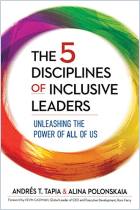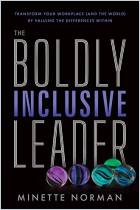Melden Sie sich bei getAbstract an, um die Zusammenfassung zu erhalten.

Melden Sie sich bei getAbstract an, um die Zusammenfassung zu erhalten.
Nadia Nagamootoo
Beyond Discomfort
Why inclusive leadership is so hard (and what you can do about it)
Practical Inspiration Publishing, 2024
Was ist drin?
Tackle the emotional and practical challenges of inclusivity to become a better leader and enhance employee well-being.
Recommendation
Biases and the discomfort that can arise when people acknowledge differences make inclusivity hard. How can you, as a leader, overcome these challenges? Chartered Psychologist and diversity, equity, and inclusion (DEI) culture change coach Nadia Nagamootoo delves into the emotional and practical complexities of achieving true organizational inclusivity. Through practical advice and real-life examples, Nagamootoo demonstrates how leaders can embrace discomfort, be vulnerable, and drive meaningful cultural transformation to enhance employee well-being and their companies’ long-term sustainability.
Take-Aways
- Businesses must embrace diversity, equity, and inclusion (DEI) to thrive amid economic uncertainties.
- Leaders seeking to nourish inclusivity tend to fall into one of four categories: “Disconcerted,” “Proof-Seeking,” “Cheerleading,” and “Beyond Discomfort.”
- Disconcerted leaders resist DEI due to feelings of exclusion, guilt over their privilege, discomfort with confronting biases, and fear of change or loss of power.
- Proof-Seeking leaders must recognize the complexity and possibilities of DEI.
- Cheerleading leaders must acknowledge their team members’ differences.
- Inclusive leadership requires self-reflection, the courage to challenge biases, and the vulnerability to support diverse perspectives.
- Achieving organizational inclusion means embracing the discomfort of inequity.
Summary
Businesses must embrace diversity, equity, and inclusion (DEI) to thrive amid economic uncertainties.
Diversity, equity, and inclusion (DEI) improve businesses’ financial performance and boost innovation. Companies with diverse leadership outperform their less-diverse peers, with top-quartile gender-diverse teams gaining a 25% financial edge.
Inclusion directly affects an organization’s ability to attract and retain a diverse talent pool, meet the evolving needs of its workforce, and enhance productivity. For example, companies that provide flexible working arrangements and supportive environments for caregivers and single parents significantly reduce turnover and access a broader range of skilled employees. Embracing inclusivity ensures businesses adapt to societal changes, such as the growing population of workers who identify as LGBTQ+ and those diagnosed with neurodivergent conditions. This adaptation helps organizations hire and retain talented workers and be better poised to serve an ever-more diverse customer base.
“There is greater urgency than ever to focus on inclusion. However, the reasons why aren’t always obvious.”
Leaders seeking to foster conversations about DEI in the workplace should ask:
- How do my team members rate the organization’s level of inclusiveness?
- Do diverse team members, those in non-majority age brackets, or those with caregiving responsibilities have different experiences from others on the team? What steps can I take to gain a better understanding of their perspectives?
- What does my organization’s online presence convey about its commitment to DEI? How might potential employees perceive my company’s brand?
- Do my company’s hybrid or home-working policies accommodate employees with varying needs? Who shapes these policies?
- How do my company’s DEI strategies relate to its thinking about the future of work and the organization’s long-term resiliency?
Leaders seeking to nourish inclusivity tend to fall into one of four categories: “Disconcerted,” “Proof-Seeking,” “Cheerleading,” and “Beyond Discomfort.”
These four categories are less about determining good leadership versus bad than about exploring the primary struggles — both emotional and practical — that even the best-intentioned leaders face when confronted with the complexity of DEI in the workplace. Each “Way of Being” calls for a different kind of self-examination and comes with unique challenges to overcome — challenges that vary based on a given leader’s openness to learning about diversity and commitment to backing DEI initiatives. When leaders understand their go-to Way of Being, they can more easily pinpoint the “whys” behind DEI-related feelings of discomfort and mindfully accept differing perspectives.
Disconcerted leaders resist DEI due to feelings of exclusion, guilt over their privilege, discomfort with confronting biases, and fear of change or loss of power.
Often, individuals from majority groups can regard DEI as unfair. These people may feel that DEI programs criticize or exclude them according to characteristics they cannot change, such as race or gender. For example, actor Steve Zahn’s character in the television show The White Lotus feels unjustly labeled as a sexist because he’s white and male, despite his efforts to oppose discrimination. Such a perception of injustice creates a sense of unfair treatment among those who don’t belong to underrepresented groups.
Many organizations try to remedy such feelings by creating systems that claim to evaluate people solely on merit. However, meritocracies often fail because most people have unknown biases. For example, affinity bias leads people to prefer candidates who resemble themselves, creating a “mirrortocracy” rather than a true meritocracy. This bias tends to be invisible to those who benefit from it. Thus, they seldom acknowledge how much of their success results from systemic favoritism.
“Challenging the system of inequity is tough, particularly for those who are used to enjoying (whether consciously or not) the power it currently offers them.”
Privilege plays a significant role in perpetuating inequities, granting unearned advantages to certain groups while disadvantaging others. Individuals can also have varying levels of privilege in different areas of life: Getting accepted to a prestigious school might grant you more privilege, while being a woman in a male-dominated career might be a disadvantage. The fear of acknowledging this privilege can render Disconcerted leaders unreceptive to DEI initiatives. To admit privilege would be — in these leaders’ minds — tantamount to admitting their own value is suspect and that they have been knowingly colluding in perpetuating systemic inequality. This view on what it means to admit privilege goes hand-in-hand with fear of change. People often view change as a zero-sum prospect. They worry that, if the status quo alters, they will lose status or face exclusion themselves.
To overcome these fears and wholeheartedly embrace and support DEI efforts, leaders must stop thinking in zero-sum terms and start exploring ways everyone can succeed. Disconcerted leaders must confront their biases, analyze their choices, pinpoint systemic advantages that brought them benefits and engage in open discussions with diverse individuals about their views and experiences. Leaders should also reflect on how unconscious preferences may have influenced their decisions.
Proof-Seeking leaders must recognize the complexity and possibilities of DEI.
To pursue DEI initiatives or programs, some leaders need proof that inequity or discrimination exists in their organizations. Inequity and discrimination often remain invisible to members of majority groups because both stem from ingrained biases and systemic structures that favor the majority.
Leaders who rely on tangible evidence can fail to recognize and address inequities and injustices because they don’t question how they think and, thus, never acknowledge their biases. For example, a white leader who is struggling to give productive performance critiques to a Black team member might feel confident that she is not harboring any racial biases. But it’s also doubtful that she has ever asked herself what underlying beliefs she holds about Black employees in general, or whether she’d be as quick to question that team member’s competence if the worker was white. Proof-Seeking leaders must challenge their assumptions and seek out diverse perspectives that enable informed, inclusive decisions.
“Often, those with a Proof-Seeking Way of Being feel discomfort with the nuances of DEI and the lack of clear data that points to a ‘right’ answer.”
Fear of the unknown can hold leaders back from acting on DEI programs because these initiatives challenge their confidence in traditional leadership approaches. Insecurity makes them hesitant to embrace inclusive practices that require vulnerability and openness. For example, “binary-thinking” leaders may struggle to accept perspectives that don’t spring from tangible data because they fear such perspectives will cause them to question their past decisions or leadership style.
Leaders should actively seek diverse viewpoints and practice self-reflection to challenge their biases and assumptions. Leaders can facilitate this process through group discussions, experiential learning, and coaching to understand inclusion and its effects.
Cheerleading leaders must acknowledge their team members’ differences.
Create an inclusive environment by recognizing people’s differences. Some leaders believe they are inclusive but, in fact, brush over any differences within their workforce. These individuals champion themselves as “cheerleaders” of DEI but remain unwilling to seek out the needs of their diverse team members.
Inclusive leadership acknowledges and addresses the unique challenges and biases individuals face. Ignoring differences means overlooking historical and systemic biases that affect people’s experiences and opportunities. Recognizing differences allows leaders to create more equitable environments by understanding and mitigating the barriers underrepresented groups face.
“In order for people to feel like they belong, you need to see their differences.”
Cheerleaders may fear the complexity of treating individuals differently based on nuanced, unseen factors. This can make the process seem overwhelming. This fear can lead to hesitation. When leaders worry about making mistakes or facing backlash for saying the wrong thing, it hinders their efforts to be inclusive. For example, they might find the rapid evolution of inclusive language daunting and worry they’ll face public criticism if they inadvertently err.
To overcome this concern, embrace the complexity of DEI work and create safe spaces for learning and experimentation. Adopt a growth mindset and view mistakes as opportunities to learn and grow rather than failures. Reflect on and adjust your beliefs and strategies to ensure they align with your goals, thus demonstrating resilience and a willingness to evolve.
Inclusive leadership requires self-reflection, the courage to challenge biases, and the vulnerability to support diverse perspectives.
Leaders must develop the courage and skill to challenge systems of inequity. Questioning these systems addresses biases in the workplace and creates opportunities for growth and inclusion. Some leaders prove adept at moving outside their comfort zones to address their biases. These “beyond discomfort” leaders learn to navigate unease and potential backlash. For example, pointing out when someone makes an exclusionary joke demonstrates how actions can promote reflection and change.
An open mindset toward DEI requires self-reflection to understand your values, beliefs, and biases. This introspective process involves acknowledging uncomfortable truths about your biases and the effects of privilege. Push yourself to evaluate and align your actions with inclusive values.
“Being an ally means walking alongside people of a marginalized community and actively demonstrating support whilst knowing that it may leave you open to criticism from others who have different views.”
To support inclusivity as a leader, implement practices that foster self-reflection and mindfulness. For example, Jon Kabat-Zinn’s centering and grounding techniques help leaders connect with their emotions and present environment. Kabat-Zinn teaches leaders to turn their focus away from their busy thoughts and toward their feelings and hearts. Through focusing on their breathing, leaders can identify their emotions without blaming others for them.
Create a culture of resilience by forming support groups to discuss DEI-related challenges and share strategies. Encourage psychological safety by organizing facilitated reflection sessions, sharing personal DEI-related experiences, and hosting “lunch and learn” sessions during which team members can discuss DEI topics and diverse perspectives.
Achieving organizational inclusion means embracing the discomfort of inequity.
Implementing DEI initiatives successfully requires your entire organization to engage collectively. Productive DEI strategy starts with the commitment and alignment of top leaders who collectively support and prioritize DEI initiatives. Apply data-driven approaches — running surveys to understand employee experiences, for example. Use the data you gather to identify areas in need of improvement and to set clear, measurable goals for DEI. For example, the organization might implement a DEI committee and appoint DEI champions to foster engagement and sustain momentum. The company can plan to measure the effectiveness of this approach using surveys to gauge employee happiness.
Consider sharing survey results and hosting regular discussions to maintain employee trust and involvement. Invest in training and workshops that teach diversity and cultural inclusion and encourage employees to share their stories and experiences to nurture empathy, understanding, and an inclusive culture.
“All leaders need to be willing to practice discomfort, both individually and collectively, in their decision-making.”
Help your organization become more inclusive by inviting diverse employees to share their experiences through anonymous surveys, case studies, and videos. Share transparent insights from these surveys to build trust and drive collective action. Align your DEI strategy with your overall organizational goals and ensure it addresses root causes. Invest in ongoing inclusive leadership programs, invite diverse voices to decision-making tables, and measure and communicate your progress to maintain momentum and celebrate successes.
About the Author
Nadia Nagamootoo is a Chartered Psychologist, accredited coach, MBA and Founder of Avenir, a DEI consultancy.
This document is restricted to personal use only.



















Comment on this summary